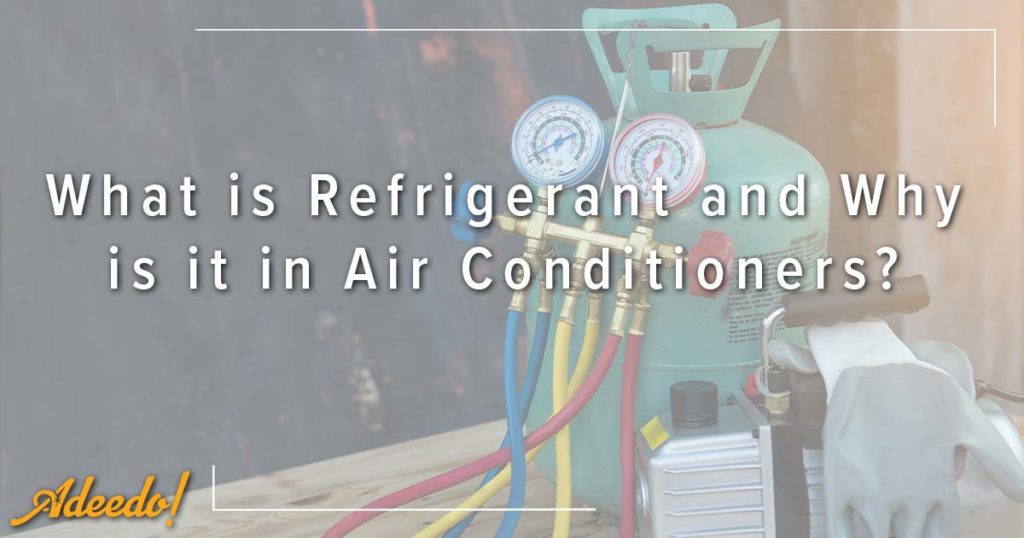Millions of homeowners rely on AC refrigerant inside their air conditioners, even if they don’t know how refrigerant works. Here we’ll discuss what refrigerant is, how it works, four common types, and signs your AC may have a refrigerant leak.
What is Refrigerant?
It’s the chemical that provides a cooling effect in many common appliances, such as air conditioners. The refrigerant changes its chemical state to provide cool air, absorbing heat from the environment. The first iteration of non-flammable AC refrigerant was developed in 1928.
What are the different types of refrigerants?
As mentioned, AC refrigerants have been around for nearly a century but have undergone significant changes. Today’s refrigerants are developed with a focus on energy efficiency and being environmentally friendly.
Chlorofluorocarbons (CFCs)
The original AC refrigerant, CFCs, are commonly known as Freon. It was widely used in air conditioners until its significant environmental impact was discovered in the 1980s. Manufacturers began to phase out the use of CFCs before they were banned entirely in 1994.

R22 Refrigerant
Sometimes called Freon 22, R-22 refrigerant is a CFC with an additional hydrogen atom. It was used as a replacement for CFCs until being phased out due to its environmental degradation. Air conditioners built and installed before 2010 likely use R-22; this may be an issue if the system needs to be recharged, as the United States has a limited and highly controlled supply for use.
R410A Refrigerant
A chlorine-free alternative to R-22, R-410A began to replace its predecessor in HVAC systems in 2010. As refrigerants have evolved, R-410A has a higher heat absorption and release rate than R-22. It has more fluidity for changing chemical states, making it more energy efficient and able to cool your home more quickly.
R-32 Refrigerant
The newest AC refrigerant available, R-32, is the most energy efficient to date, reducing energy bills by nearly 10%. It also has a significantly lower — 32% — Global Warming Potential than R-410A.
How Does AC Refrigerant Work?
- Compress: The refrigerant is in its low-pressure gas state when it enters the compressor. As the gas molecules are compressed, they heat up as the pressure increases.
- Condense: Now a hot gas, the refrigerant moves into the condenser, where fans blow across the coils and cool the gas inside. The pressure inside the coils pulls the refrigerant molecules together again, condensing them back into a liquid.
- Measure: A metering device monitors whether the refrigerant moves at a constant pace and if the AC needs to continue cycling or maintain the current temperature.
- Evaporate: Inside the evaporator, the low-pressure liquid form begins to boil inside the coils as fans blow over the coils. The refrigerant evaporates into gas while also absorbing the heat inside your home — causing the temperature to drop. Fans blow this cool air into your home as the refrigerant travels back to the compressor as a warm but low-pressure gas to start the cycle again.
Signs Your AC Needs Refrigerant Work
It’s relatively uncommon to have refrigerant as the reason your air conditioner needs work, but it does happen.
AC is on, but no cool air is coming out
This is usually a sudden change; double check the thermostat is set to cool mode. If it is, the AC could have a refrigerant leak. The system struggles to provide the right amount of cool air without adequate refrigerant.

Coils are Frozen
The indoor portion of your AC houses the evaporator coils where the refrigerant flows during regular operation. But without the right amount of refrigerant, the coils will frost or freeze over. This usually causes the AC to shut down until the system is recharged.
You Hear a Bubbling or Hissing Sound
This sound is usually the sound of refrigerant escaping through a hole or tear in the refrigerant line. It may also come from the copper coils as this is where most of the refrigerant flows when the air conditioner is running.
You haven’t had a tune-up in a while
Scheduled tune-ups allow a trained HVAC technician to thoroughly look over your air conditioner and repair any issues, such as leaking refrigerant. Without regular checks, a leak will continue and possibly cause substantial damage to the air conditioner.

How Can I Fix an AC Refrigerant Leak?
Call your HVAC company. Their technicians have the training and equipment to repair and recharge the air conditioner appropriately. Because refrigerant is harmful if ingested or inhaled by people and animals, it’s important not to attempt a repair yourself. Plus, the high-pressure levels inside the air conditioner need to be correctly calibrated, or the AC may be irreversibly damaged.
Homes have relied on AC refrigerants to provide indoor comfort for nearly 100 years and will continue to do so. If your air conditioner has a refrigerant leak, or any other issue, contact Adeedo for professional HVAC service today!

 Schedule Service
Schedule Service